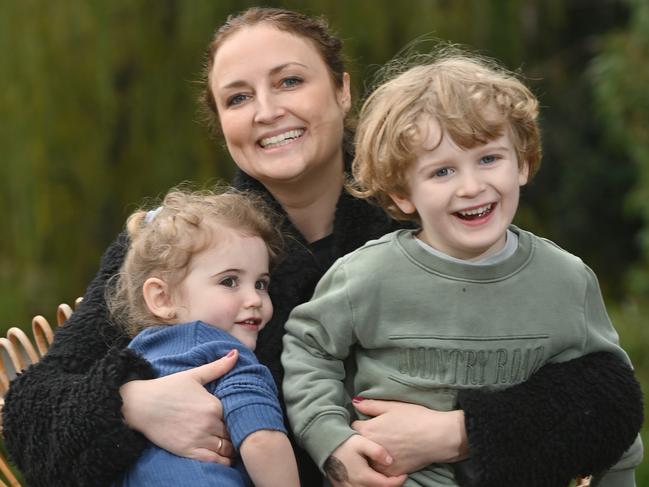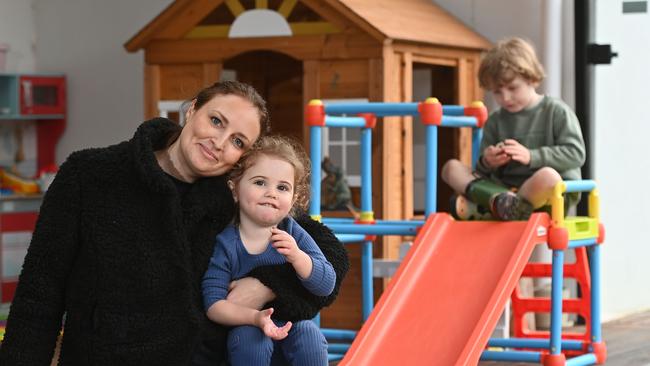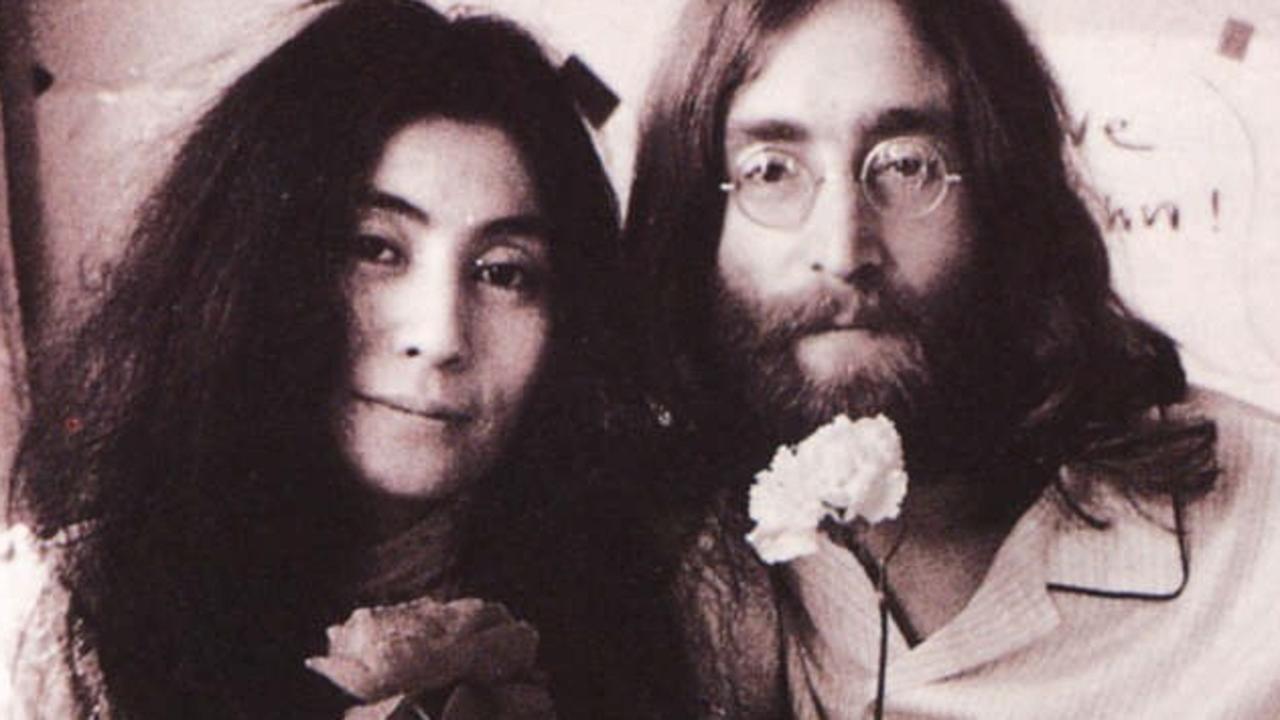‘I felt like I was going to die’: Inside an Adelaide mum’s desperate battle with postnatal depression
At her lowest point, new mum Natalie Trainor stopped eating and drinking and waited to die after having her first child.

SA Weekend
Don't miss out on the headlines from SA Weekend. Followed categories will be added to My News.
She didn’t want to die. She didn’t want to leave her little boy. But new mum Natalie Trainor was becoming increasingly sure that her life was going to end.
“I desperately didn’t want to die because I had my baby but I just felt like I was heading down a doomed path,” she says.
“I started having paranoid thoughts. I had psychosis as well. It was a sense of doom. I was on edge the whole time. I felt like I was going to die, that I had to die.”
It was at this point that the then 33-year-old’s worried family took her, in desperation, to the emergency department.
What followed was the scariest period of her life, as Natalie was admitted to a psychiatric ward and separated from her four-month-old son, August.
She was later diagnosed with postnatal depression and psychosis. She stopped eating or drinking and underwent electroconvulsive therapy (ECT) in a bid to “reboot” her brain and effectively save her life.
The fact that, five years later, Natalie is healthy, happy and home with August and his younger sister Lottie, is in large part thanks to the team of experts at the only mother and baby mental health unit in South Australia.

INSIDE HELEN MAYO HOUSE
There are just six beds available at Helen Mayo House, where parents struggling with significant mental distress can be admitted with babies in their first year of life.
After spending a week in the Flinders Medical Centre psychiatric ward, separated from August, Natalie was referred to Helen Mayo House and reunited with her son.
“It feels like a nest,” she says of the facility at Glenside.
“It’s a supportive place where you can access around-the-clock care and they teach you how to look after your baby. You’re there to rest and recover. I question if I would have become well (without it) because I needed to be with my baby.”
Last year, 64 parents and 66 children – including twins – were admitted to Helen Mayo House. Each year between 60 and 100 patients spend time there, ranging from teenage mothers aged 16 or 17 to women in their 50s.
On average, a mother and baby will stay for two to three weeks but it is not uncommon for patients to stay for months. Because of this there are usually five to 10 families on a wait list, and this can blow out to 15 or 20.
Given the dire need for this small but lifesaving service, there are plans to double capacity to 12 beds when Helen Mayo House moves to the site of the new Women’s and Children’s Hospital.
Health Minister Chris Picton says modelling shows 12 beds will be enough to “meet demand into the future”, but the WCH is not due to open until at least 2030.
In the meantime, there are growing calls for more education for families about the realities of pregnancy, birth and parenting to prevent more mums, dads and babies sliding into crisis.
THE SHOCK OF MOTHERHOOD
Thinking back, Natalie Trainor says she was “clueless as to what was to come”.
“My pregnancy was great, I really cruised through. I was so excited,” the now 38-year-old says. She had a history of experiencing depression in her mid 20s but says this wasn’t discussed as a risk factor with her doctor or obstetrician.
After August’s birth in 2018, the complete life change that comes with being a first-time parent took her aback.

“It’s a huge learning curve, the first baby,” she says. “For a long time I felt like if I wanted to lay down there was a guilt in me that I should be doing something; that (resting) was a luxury.
“I think that was why I fell off the cliff. There wasn’t just a lack of support but there was pressure and expectation on me and a sense of obligation. There was also lack of sleep. I felt angry and frustrated.
“I was definitely mentally exhausted … struggling to adapt to a whole new way of life, not working any more, feeling isolated. My anxiety was through the roof.”
When things began to feel unmanageable, Natalie took the first step of visiting a GP but says her concerns were downplayed.
“They weren’t really labelling it as mental health. One doctor kind of mentioned postnatal depression but there wasn’t really a plan, no pathway (to support),” she says.
Nationally one in five new mothers, and one in 10 new fathers, will experience depression, anxiety, trauma or stress-related disorders associated with pregnancy or early parenthood.
That is more than 100,000 new parents around the country each year. In addition, more than half of all new parents will experience what is known as an adjustment disorder as they confront the reality of life with a newborn.
The cost of peri-natal depression and anxiety on families, workplaces and the wider community was estimated by PricewaterhouseCoopers in 2019 to be about $877m. That analysis was undertaken at the request of the Gidget Foundation, which was set up in honour of a young Sydney mother who took her life while suffering postnatal depression.
Suicide remains a leading cause of death among expectant and new mothers.
In Adelaide, Dinah Thomasset founded mother’s support charity Villagehood Australia after experiencing a bout of debilitating postnatal depression.
In the past year alone she has been told of four local mothers who have taken their lives, including one death just before Mother’s Day this year.
“It breaks my heart … thinking about that 18-month-old baby who went to bed tonight without the warm cuddles of his mother. It’s not fair,” says Thomasset, who is lobbying federal Health Minister Mark Butler to provide more funding to prevent maternal suicide.
“No child should have to go through such a heartbreaking loss at such a young age.
“This is not just a passing moment of sadness or an isolated incident. It is a constant struggle that so many mothers silently face, feeling invisible, helpless, and without hope.
“We need to let them know that it’s okay to ask for help, to admit when they’re feeling overwhelmed, and to reach out for support.”

Severe depression and anxiety are the most common reasons parents are admitted to Helen Mayo House, but medical unit head Dr Rebecca Hill says they see cases of post-partum psychosis or pre-existing bipolar disorder and schizophrenia too.
“There is a small group of women who have their first episode of psychosis after having a baby,” Hill says, explaining that post-partum psychosis is known to affect about one in 1000 people. “(We see) women with more severe disturbances of their ability to test reality. They might be having hallucinations or delusions where they’re thinking things that aren’t true.
“Often (mothers) might feel that their baby isn’t all that interested in them or prefers other people. Or they might feel so unwell that it feels as though it’s not really their baby.
“That is actually one of the hallmarks of a more severe depression.
“If you’re stuck in a house by yourself for 10 hours a day with a baby who won’t stop crying, who you think doesn’t like you, and you can’t sleep a wink even when the baby does, no wonder you feel terrible.”
In these situations, mothers can begin to think this is just what parenthood is like, which Hill says “can then be connected to suicidal thinking – if this is what it is, I don’t want it”.
“It shouldn’t have to be like this,” she says. “Your baby needs you to take care of you too.”
FALLING DOWN THE RABBIT HOLE
Natalie likens her descent into postnatal depression and psychosis as like Alice falling down the rabbit hole and ending up in Wonderland.
“It really did feel exactly like that,” she recalls. “As she’s falling, there is the progression of the symptoms. It felt like falling in the bottom of the rabbit hole and being in this funny land. I was in a different dimension almost.”
That landing came when she and her husband Ed travelled interstate for a wedding when August was about three months old.
She had been feeling increasingly anxious for months, guilty that she wasn’t doing enough as a mum, that she was letting her family down, under pressure to do things differently but unable to set boundaries.
“I had started to feel very anxious,” she recalls. “I found it really hard to get out of the house … get the baby in the car, drive anywhere. It was just way too much of an effort.”
Arriving interstate for the wedding, away from the cocoon of her house and routine, her brain began sending her warnings that she was “not safe”. “It was terrifying. It all crept up on me,” she says. “I became progressively more frightened and fearful and paranoid. I didn’t talk about it. They couldn’t experience my inner world.”

Trying to understand what was happening, she returned to Adelaide and visited four different GPs. One mentioned the possibility of postnatal depression, she says, while another suggested she should “grow” from the experience. “I had a number of stigmatising comments. One doctor said to me, ‘Do you have a hobby?’ as if that would fix it,” she says.
In the following weeks she continued to worsen until her family decided the only option was to take her to the Flinders Medical Centre emergency department. “I was admitted to the psychiatric ward there which was horrifying because they took my baby,” she remembers. “It was so traumatising because I just desperately didn’t want to be separated from him.”
After a week in the psychiatric ward, Natalie was referred to Helen Mayo House, where she stayed with baby August for the next 10 weeks.
“I was just a bubble of fear,” she says of her state upon arrival.
The medical team began trialling medications but Natalie says her condition “kept declining”. Then she stopped eating.
“My family was saying, ‘You need to eat’ but I truly felt I wasn’t meant to … because I was meant to die. I was thinking I’m not meant to eat, I’m not meant to drink,” she says.
This was the trigger for trying ECT.
Hill says the procedure involves putting a patient under general anaesthetic and inducing a seizure which results in the release of neurotransmitters in the brain. This is thought to work in the same way as medications but is “a much more powerful release”.
“The major features of ECT are that it is rapid and highly effective, both of which are things you want when someone is missing out on time with their baby,” Hill says.
“It is probably the most commonly performed procedure in the world. People have it three times a week … (and) everyone who has it probably has six to 12 treatments. But no one really talks about it much in the community.
“Sometimes it is lifesaving if people are so suicidal that we can’t necessarily even guarantee their safety in a mental health unit. Or if they’re not eating and drinking. To be better within a couple of weeks is much better than taking weeks and weeks of medication.”
Natalie remembers being nervous before undergoing ECT for the first time.
“I definitely didn’t believe it was going to work,” she says. “You don’t feel it. You wake up having not felt anything. It was like mending a broken computer. It just reboots your brain and breaks that cycle of disordered thinking.”
RECOVERING FROM POSTNATAL DEPRESSION
Slowly, over the next few weeks, Natalie began to feel better. She was stabilised on medication and spent time working with the Helen Mayo House team of nurses, social workers, psychologists and psychiatrists.
They made a plan for continued treatment and support. Then it was time to go home.
At first things felt better, but with hindsight she has come to realise that some of the same triggers for her mental distress were still present.
A key turning point was when she “naively” decided to wean off her medications and “my symptoms returned”.

By the time August was about 18 months old, she was readmitted to Helen Mayo House with her son. She adjusted her medication and underwent ECT again – this time while about 10 weeks’ pregnant with her daughter Lottie.
After about seven weeks she was discharged and second time around she made some significant changes.
“I felt so relieved and just grateful that I survived,” she says.
“I felt like I was in the driver’s seat. I became more open about what support I needed.”
Since being discharged she has learned to set boundaries for her mental health, and continued with medication and appointments with a psychiatrist and psychologist.
She is back working as a speech pathologist at her own practice and enjoying life with her “sweet, sensitive” son and “smart, cheeky” daughter.
“They adore each other, they’re best friends – but it’s also a bit of love and war,” she laughs.
Now Natalie acts as an advocate for awareness around maternal mental health. She wants more education for families planning a pregnancy, and more structured mental health screenings for pregnant women.
There is a mental health survey women are supposed to be given at their six-week post-birth check up, with a GP or obstetrician, but it is not always offered, or women may not self-report red flags.
“This is a very vulnerable time,” she says.
“It should be like checking iron levels or blood pressure. Often we talk about getting the cot ready, getting the car seat, but what we should be doing more of is asking, ‘What’s your plan for when you go home (from hospital)? Who will be there to support you?’
“I’ve had comments that we don’t want to scare women, so everyone’s tiptoeing around the conversation, but we have a right to be informed.”
While her traumatic experience may have been avoided with earlier support, Natalie believes her time at Helen Mayo House – and the struggles that led her there – have made her a stronger and more compassionate person.
“At first you feel the stigma but now I’ve come through to the other side where, if people judge me for knowing this, it doesn’t matter,” she says.
“I feel back to me, I probably feel stronger in a way. You want to break the cycle too and I’m doing that for my kids.”





